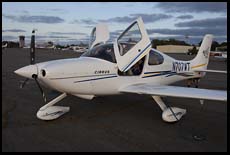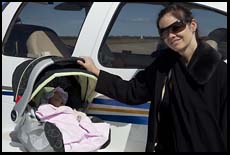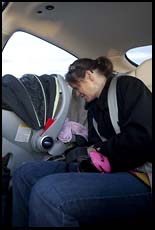

|
Cirrus Accident Investigationby Philip Greenspun, Ph.D., ATP, CFII and Adam Harris, CFI, A&P and IA; updated July 2011 |
 The accident record of the Cirrus SR20 and SR22 airplanes is worse
than that of the four-seat Cessna 172 and Diamond Star DA40. A major
factor in this difference is how the airplanes tend to be used. The
Cirrus planes are fast, comfortable, and can fly as far as 1000 miles
without refueling. People therefore tend to use the airplanes for
scheduled and long-distance trips whereas the Cessna and Diamond
airplanes are more frequently used for training.
The accident record of the Cirrus SR20 and SR22 airplanes is worse
than that of the four-seat Cessna 172 and Diamond Star DA40. A major
factor in this difference is how the airplanes tend to be used. The
Cirrus planes are fast, comfortable, and can fly as far as 1000 miles
without refueling. People therefore tend to use the airplanes for
scheduled and long-distance trips whereas the Cessna and Diamond
airplanes are more frequently used for training.
A scheduled trip is more dangerous than a training flight because it is more difficult to tell the family "We're not going to the beach this weekend" or the client "I can't visit you today" than it is for a flight instructor to tell a student "Let's go another day when it won't be so cloudy/windy/rainy."
A long-distance trip is more dangerous than a training flight because the pilot will be traveling through multiple weather systems, each of which presents a risk of instrument meteorological conditions, icing, turbulence, hail, and other hazards. The long-distance trip involves visiting unfamiliar airports. At his or her home airport, a pilot will often rely on visual crutches, e.g., "turn base to final over the highway", that aren't available at a new airport.
Note that by these standards, it is a miracle that you have survived your few airline trips. The airline tried its best to keep to a schedule, despite often miserable weather, the distances covered were vast, and the destination was one that the pilots might not have visited for months. How is it possible for the airlines to be safe? They assign two pilots to every flight, who share flying and monitoring duties. Those pilots get recurrent training every 9-12 months and then fly the airplane between 15 and 20 days per month. If the clouds are forming ice on the wings, the Boeing 737 has channels for hot air behind the leading edge to melt it off. More importantly, the Boeing 737 can climb 4,000 feet per minute into more favorable weather conditions; it will be on top of the clouds after a few minutes, rather than plowing through them.
Aside from the fact that the airplanes tend to be used for long trips, one factor that may contribute to maneuvering accidents is the unusual spring-loaded flight control design. A typical light airplane provides some warning of an impending stall because the reduced airloads on the control surfaces make the stick feel "floppy". The Cirrus, on the other hand, has fairly stiff controls even when taxiing. A pilot's only warning of an imminent stall is therefore the stall warning horn.
The fuel indication system on the Cirrus is poorly placed, just in front of the center armrest and separated from all of the other gauges. A pilot who fails to include this out-of-the-way location in his or her scan may find a significant fuel imbalance developing. This has led to at least one accident in which the autopilot could no longer hold the airplane level against the imbalance and tripped off, resulting in the disoriented pilot believing that the airplane had gone into a spin and deploying the parachute (the airplane was destroyed upon reaching the ground in the mountains of British Columbia; fortunately nobody was injured).
A final safety problem with the Cirrus is the sheer volume of avionics packed into the panel. In theory it sounds nice to have as many displays, dials, and gauges as possible. In practice, most of the pilot's attention should be devoted to holding the plane reasonably level and looking out the window. A traffic warning system, for example, could be a useful safety enhancement in the airliners for which it was developed. One pilot can look out the window while the other puts his or her head down to look at the traffic display. In a single-pilot airplane such as the Cirrus, it is an open question as to whether the plane can be made safer by bombarding the pilot with additional information available only on heads-down displays.
The authors do not intend to suggest that Cirrus aircraft are inherently unsafe. With an appropriate program of initial and recurrent training, and continuing good judgement by the pilot, the SR20 and SR22 certainly can be operated safely. The authors fly Cirrus aircraft regularly on training, maintenance, and business flights.
Via FAR 61, the FAA sensibly requires the following before a person can act as pilot in command of an aircraft carrying passengers:
Insurance companies often impose more stringent requirements, e.g., recurrent training on an annual basis. In order to guarantee the ticket-buying public a higher level of safety, the FAA similarly imposes more stringent requirements on pilots of commercially-operated aircraft, e.g., ground and flight tests every 12 months for charter pilots (FAR 135.293) and proficiency checks every 6 months for airline pilots (FAR 121.441).
Regardless of legal or insurance requirements, a generally prudent pilot's logbook will show a reasonable amount of recurrent training. What's reasonable? A guy who flies his family to a vacation house every weekend will probably need at least a few hours annually to brush up on emergency procedures. A working flight instructor who is teaching emergency procedures regularly to students might need only a quick check.
All of the required information to establish pilot currency should be in a pilot's logbooks and FAR 61.51 requires that such logbooks be kept. If the pilot logbook was destroyed in the accident, try to get the pilot's most recent insurance application. That should include such items as "hours flown within the last 90 days" and the dates of flight reviews or other recurrent training.
A potentially very valuable source of information is the instructor who last provided training to the accident pilot. That instructor may have records of what maneuvers and procedures the accident pilot had the most difficulty with.
 An NTSB factual report will typically have some weather information,
but a more complete record should be obtained from National Climatic Data
Center and/or the convenient Plymouth State
Weather Center.
An NTSB factual report will typically have some weather information,
but a more complete record should be obtained from National Climatic Data
Center and/or the convenient Plymouth State
Weather Center.
If the weather was below visual flight rules (VFR) minimums, check to make sure that the Cirrus was on an instrument flight plan and that the weather was consistent with forecasts. Even experienced instrument airplane pilots have trouble when inadvertently entering the clouds. They might be capable of planning and executing an instrument flight, but when forced to transition suddenly from outside visual references to the gauges inside the aircraft, they become disoriented.
If the accident happened during the approach phase of the flight, look at the instrument approach procedure and compare the required weather minimums to the actual weather. See this video on briefing an instrument approach for a tour of what's on a typical approach plate. For a concrete example, the ILS 29 approach at Hanscom Field requires a minimum ceiling of 200' above the runway and at least 1/2 miles of visibility. If you work out the geometry of the approach, given the stated glide slope angle of 3 degrees, the threshold crossing height of 54', and the fact that the glide slope terminates roughly 1000' down the runway, at 200' above the runway the airplane would be roughly 4000' feet from the touchdown zone and therefore 3000' from the runway threshold (more than the 2640' of "1/2 mile"). Thus when the weather was actually at minimums there would seem to be no way that the pilot would be able to see the runway and continue towards a landing. However, the plate also notes the presence of a MALSR (Medium Intensity Approach Lighting System). Under FAR 91.175, if the pilot can see this approach lighting system, continuing the approach to 100' above the ground is authorized, at which point the runway should become visible (if it does not, the pilot must execute a "missed approach", climbing back up into the sky and perhaps trying a different approach at an alternate airport).
How safe is it to fly an airplane to within 100' of the ground without seeing a runway? For a two-pilot professional flight crew, with one pilot looking outside for the runway and the other looking inside at the instruments, the operation isn't that challenging, partly because it is practiced frequently in a very realistic simulator (the instructors always set the visibility to the minimum). For a private pilot operating without a copilot, it would almost always be unwise to attempt to fly right down to the FAA minimums.
If the temperature on the ground was less than 50 degrees Fahrenheit and the flight was through the clouds, look at the temperatures at the altitudes where the plane was operating and consider whether airframe icing could have contributed to the accident.
The only authoritative source of weight and balance information is the pilot's operating handbook (POH) shipped with the airplane. If the POH was destroyed in the accident, the weight and balance records should be obtainable from Cirrus and any changes noted in the aircraft maintenance logs.
An overweight airplane has a higher aerodynamic stall speed, thus making accidents while maneuvering more likely. An overweight airplane has reduced climb performance, which can result in takeoff and climb-out accidents, particularly in hot or high altitude conditions or in mountainous terrain.
[Note: The SR20 has a rather anemic climb rate even within its gross weight, either the original 3000 lb. gross weight or the 3050 lb. gross weight that Cirrus was able to get certified for the Garmin G1000-equipped SR20. A 200 horsepower engine is, by modern standards, not very big for an airplane this heavy. The SR20 needs a significantly longer runway than, for example, the modern Cessna 172 or Diamond DA40.]
If the pilot survived the accident, the pilot's own report can be very informative. Was the operation conducted with a prudent fuel reserve? Was the pilot familiar with the gross weight limitation of his or her aircraft? Does the pilot's estimated weight at the time of the accident make sense given the fuel, passengers, and bags on board?
The NTSB factual report is also helpful, but keep in mind that the agency does not go all-out investigating the crash of a four-seat piston airplane. Sometimes they delegate fact-finding to local FAA personnel, to factory representatives, or to operators. Oftentimes the report will simply say, for example, that an engine stopped "for unknown reasons".
The NTSB probable cause report is not admissible in court and cannot be relied upon by an expert witness.
It is a straightforward matter to start by investigating whether or not the Cirrus was legally maintained by the operator.
Like all civil aircraft in the U.S., the Cirrus must have had a annual inspection within the preceding 12 months, signed off by an FAA-certificated mechanic with Inspection Authorization (IA) or by an FAA-approved Repair Station. If the most recent "annual" was signed off January 12, 2011, for example, the machine is legal to fly through January 31, 2012. Similarly, the Cirrus's transponder must have been tested in accordance with the FARs (e.g., 91.413) within the preceding 24 months and the pitot-static system must have an "IFR cert" within the preceding 24 months.
There are additional maintenance requirements for a commercially-operated Cirrus, such as one at a flight school. A commercially-operated aircraft must have inspections every 100 hours or, in some cases, on a different schedule if the flight school has received FAA approval to conduct progressive inspections. Finally there are manufacturer-recommended maintenance procedures at 50- and 100-hour intervals. In most cases, these are not legally required for operators, but may serve as a reference for a FAR 135 or FAR 121 maintenance manual.
A maintenance requirement that is peculiar to the Cirrus is that the parachute must be overhauled every 10 years and the "pyrotechnic line cutters" every 6 years. This is explained in Cirrus Service Information Letter SIL 10-01. Note that the clock starts when the parachute is installed in the airframe at the factory, not when the aircraft is first delivered to a customer. Without a properly maintained parachute, a Cirrus is unairworthy. If for no other reason, this is because the parachute is the sole demonstrated means of spin recovery in a Cirrus.
Federal Aviation Regulations (14 CFR but generally "FARs") restrict maintenance on certified aircraft to FAA-certificated mechanics. The only exception is that certificated pilots may, under FAR 43.3, perform some preventive maintenance where "preventive" is defined with an explicit list of tasks in Appendix A to FAR 43. If the pilot were to perform, for example, an oil change, he or she is required to log the maintenance in the aircraft's logbooks and include his or her certificate number in the log entry.
Did you notice any equipment in the Cirrus that was not factory-standard? If so, you should be able to find paperwork for a Supplemental Type Certificate (STC) or FAA Form 337.
Bad or inconsistent paperwork doesn't cause accidents, but aircraft that have received high quality maintenance almost always have high quality paperwork.
Who can perform this analysis? The best qualified person to conduct a logbook and aircraft wreckage inspection is an FAA-certified IA with experience in buying and selling used aircraft. The kinds of logbook anomalies that might explain an accident are similar to the kinds of logbook anomalies that experienced mechanics look for during a "pre-buy" inspection of an aircraft.
Try to find out if any equipment was inoperative at the time of the accident and, if so, it was required under the limitations established in Section 2 of the POH.
The majority of Cirrus aircraft come equipped with one of three autopilots: the S-TEC 55x, the Avidyne DFC 90, and the Garmin GFC 700. The S-TEC 55x is an analog autopilot that gets its information from a mechanical turn coordinator buried within the Cirrus instrument panel. It gets no information regarding the aircraft attitude or airspeed and therefore, if not carefully monitored by the pilot, can put the aircraft into unsafe attitudes (like the autopilot in the Colgan 3407 crash that claimed 50 lives; see this February 2010 blog posting). The Avidyne and Garmin autopilots are digital machines that get attitude information from the primary flight display. They both offer "envelope protection" in which, even if the pilot sets up an unreasonable situation by, for example, telling the autopilot to hold altitude while simultaneously pulling back power, the autopilots will refuse to pitch up the airplane and allow airspeed to decay towards a stall.
On the Cirrus, a working autopilot can be compromised by at least two mechanical factors: a sluggish trim cartridge, an improperly bent aileron trim tab. If the aileron trim cartridge is not responding to an applied voltage the way that it did when new or the aileron trim tab is bent to favor a particular roll direction, the autopilot will have trouble intercepting a navigation course or localizer. The airplane may weave chaotically back and forth and the weaving gets alarmingly worse as the plane gets closer to the ground on an instrument landing system approach.
Even if the "brain and arms" of the autopilot are working perfectly, a confused or distracted pilot can apply settings that put the aircraft into a dangerous position. It is worth trying to figure out the last time that the pilot had training on using the autopilot's many modes.
Keep an open mind until the day that you complete your expert report (and even after, if new evidence is presented).
Adam Harris holds Airframe and Powerplant as well as Inspection Authorization FAA certificates for aircraft maintenance. He also holds Commercial Pilot and Flight Instructor certficates. Harris started flying in 1990 and has been Head of Maintenance at East Coast Aero Club since 1999.
The authors have served as expert witnesses in litigation stemming from aviation accidents.